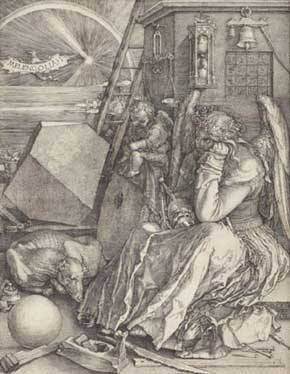
Albrecht Dürer
Melencolia I, 1514
Engraving
9 7/16 x 7 5/16 inches (240 x 186 mm)
Bequest of Belle da Costa Greene; 1950.33
‘Defining Beauty’: Albrecht Dürer at the Morgan Library and Museum In an exhibition at The Morgan Library & Museum opening May 18, 2010, eight extraordinary drawings by Dürer demonstratethe variety and dynamism of his draftsmanship
May 18 – September 12, 2010
]]>
Source: Morgan Library and Museum
“Albrecht Dürer was one of the greatest, most inventive artists of alltime,” said William M. Griswold, director of The Morgan Library &Museum. “His range and skill in a variety of media are extraordinary,and his pursuit of the idea of beauty singular and obsessive. To experience the Morgan’s spectacularcollection of Dürer drawings in the small, almost chapel-like setting of the Thaw Gallery is to come face toface with pure genius.”
Among the many highlights of the exhibition that demonstrate Dürer’s preoccupation with beauty are hisseminal engraving of 1504, Adam and Eve, along with its most important extant related preparatory drawing.To create the work, Dürer joined several sheets of paper, then unified the composition with brown wash tocreate a perfect balance between the two figures. Dürer’s efforts to resolve the composition are evident; bothfigures hold the apple that led to their expulsion from the Garden of Eden. Ever cognizant of his authorship,Dürer added his monogram and the date to the drawing. This iconic image, perhaps more than any other,documents how the artist strove to create both beauty and harmony in his depictions of the human form.
Demonstrating the persistence of Dürer’s fascination with perfectproportions is another work from about a decade later, Head of a Man inProfile. By overlaying a grid on a man’s head delineated in pen and brownand red ink, Dürer used geometry to construct a profile withmathematical precision. Also on view is a 1532–34 edition of hislandmark treatise, Four Studies on Human Proportion, a book in which hearticulated his artistic philosophy and the centrality of proportion in hisdepictions of the human body.
Dürer, however, did not limit himself exclusively to a mathematical ideal.He also turned to the natural world as a source for his art. During Dürer’slifetime, empirical observation became increasingly valued throughoutnorthern Europe, as exemplified by the accurate topographical view of his hometown in the NurembergChronicle of 1493. One of the most famous printed books of the fifteenth century, it was published byDürer’s godfather, Anton Koberger. A similar commitment to observation is evident in the rugged featuresand fuzzy textures of Dürer’s unidealized charcoal portrait of his brother Endres. For Dürer, perfection couldexist in no single individual; he appreciated humanity’s variation and even its flaws.
Follow us on:

